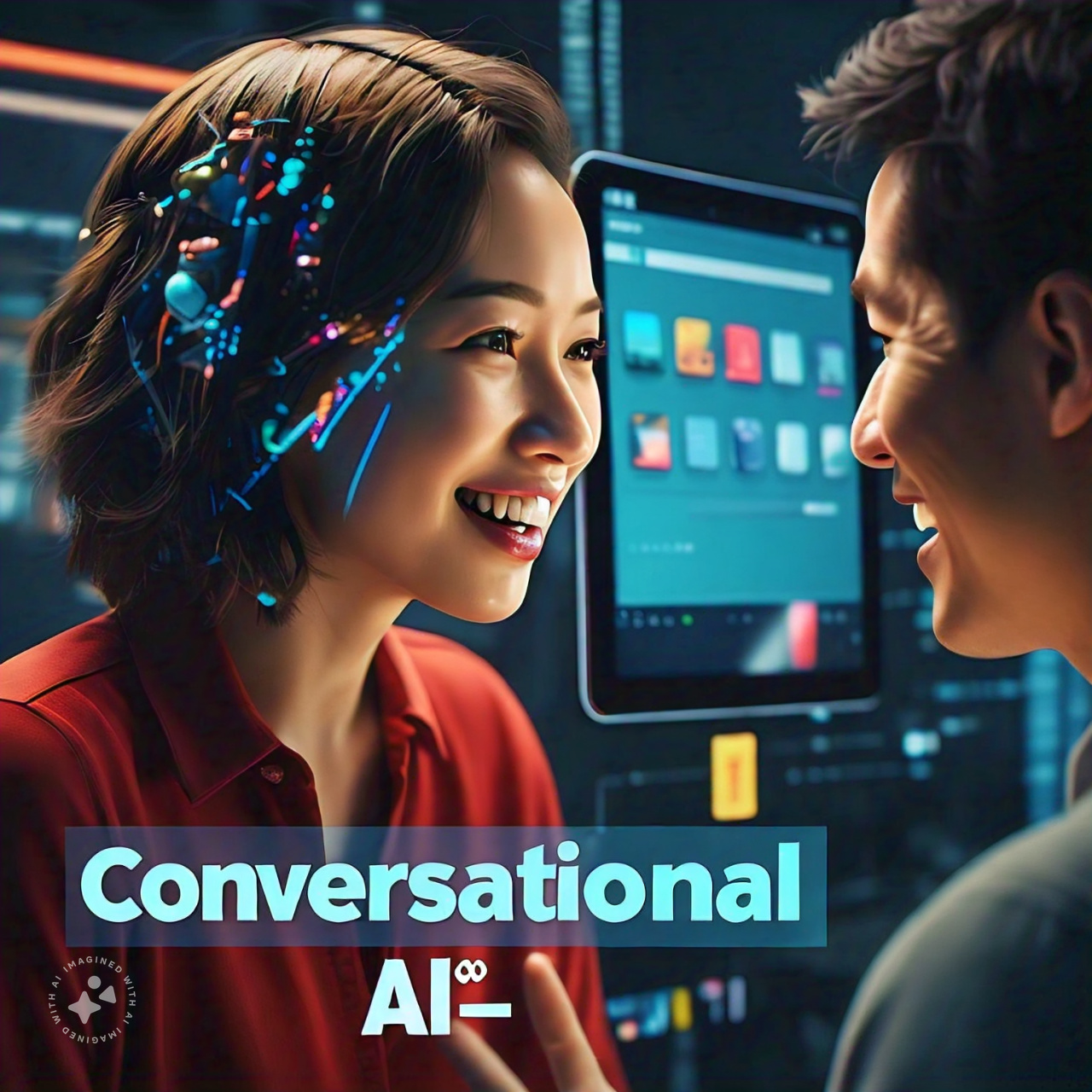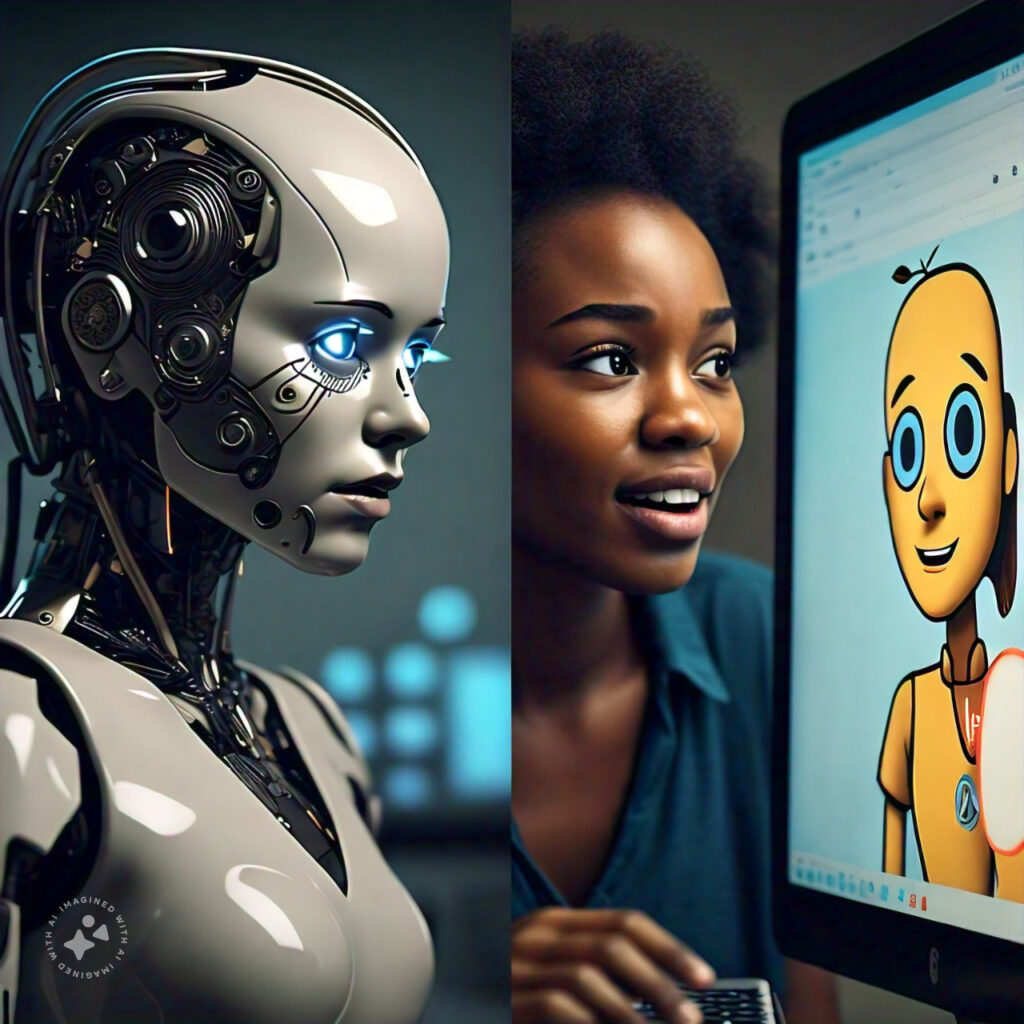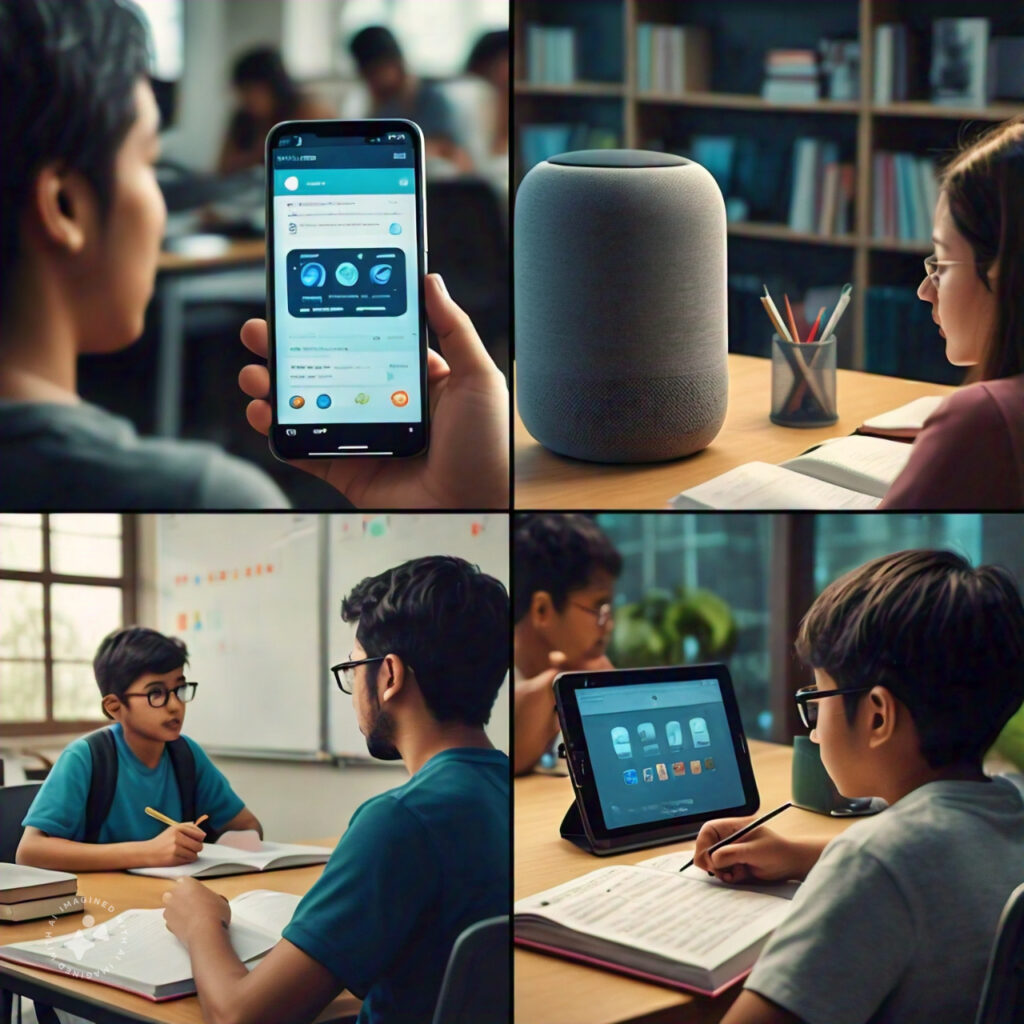
Conversational AI! Imagine a world where your morning coffee chat isn't with a bleary-eyed coworker, but with an AI that knows your preferences better than your best friend.
Sound far-fetched? Welcome to the era of conversational AI, where machines don't just talk – they understand, learn, and even crack jokes.
 Caption: Stuck on hold? Conversational AI can help (text suggests Conversational AI offers solutions that could improve customer service wait times).
Caption: Stuck on hold? Conversational AI can help (text suggests Conversational AI offers solutions that could improve customer service wait times).Did you know that the global conversational AI market is projected to skyrocket from $9.9 billion in 2023 to a staggering $57 billion by 2032?
That's a compound annual growth rate of 21.9%! Intellias, 2024
As AI becomes increasingly adept at mimicking human conversation, where do we draw the line between artificial assistance and genuine human connection?
Last week, I found myself in a heated debate about climate change… with a chatbot. Its arguments were so well-researched and articulated that I forgot I wasn't talking to a human expert.
That's when it hit me: conversational AI isn't just changing how we interact with technology; it's revolutionizing how we access and process information.
Conversational AI, at its core, is the technology that enables machines to understand, process, and respond to human language in a natural and meaningful way.
It's the brain behind those chatbots that pop up on websites, the voice assistants living in our phones, and even the sophisticated systems handling customer service inquiries.
Conversational AI: By the Numbers
Adoption of Conversational AI by Industry
Benefits of Implementing Conversational AI
Conversational AI Market Growth
Year
Market Size (Billion USD)
Growth Rate
2020
4.8
22%
2021
6.8
41.7%
2022
10.5
54.4%
2023 (Projected)
15.7
49.5%
2024 (Projected)
22.6
43.9%
But how did we get here? The journey of talking machines is as fascinating as it is long. From the clunky, rule-based
systems of the 1960s to today's sophisticated neural networks, the evolution has been nothing short of remarkable.
Remember ELIZA, the first chatbot created in 1966? She could only parrot back responses based on keywords.
Fast forward to 2024, and we have AI systems engaging in nuanced conversations, understanding context, and even picking up on emotional cues.
The latest breakthrough? Multimodal conversational AI. These systems don't just understand text; they can process and respond to images, audio, and even video.
Google's recent integration of multimodal AI into its Lens feature is a prime example, allowing users to combine image and text queries for more comprehensive results.
As we stand on the brink of this AI revolution, one thing is clear: the way we communicate with machines – and
perhaps with each other – is changing forever. Are we ready for a world where our most engaging conversations might be with artificial intelligence?
II. The Building Blocks of Conversational AI
Conversational AI is like a digital brain that allows machines to chat with us naturally. Let's break down the key components that make this possible:
 Caption: Conversations that feel human: Conversational AI - Natural and engaging interactions powered by intelligent technology.
Caption: Conversations that feel human: Conversational AI - Natural and engaging interactions powered by intelligent technology.A. Natural Language Processing (NLP): Teaching computers to understand us
Imagine trying to explain a joke to someone who takes everything literally. That's what computers were like before NLP came along.
NLP is the magic that helps machines grasp the nuances of human language, including context, sarcasm, and even emojis.
According to a recent study by Grand View Research (2023), the global NLP market is expected to reach $127.26 billion by 2028, growing at a CAGR of 25.7%.
This explosive growth shows just how crucial NLP has become in our increasingly digital world.
NLP works by breaking down language into smaller pieces:
- Tokenization: Splitting sentences into words
- Part-of-speech tagging: Identifying nouns, verbs, adjectives, etc.
- Named entity recognition: Picking out names of people, places, and things
- Sentiment analysis: Figuring out the emotional tone of a message
Fun fact: The latest NLP models can now understand over 100 languages, making global communication easier than ever!
Key Insights: Conversational AI
The Future of Customer Interaction
Conversational AI is revolutionizing how businesses interact with customers. By 2025, it's estimated that 95% of customer interactions will be powered by AI, leading to faster response times, personalized experiences, and significant cost savings.
Learn More
Breaking Language Barriers
Advanced Conversational AI systems can now understand and communicate in over 100 languages, making global business communication seamless. This technology is bridging cultural gaps and opening new markets for businesses worldwide.
Explore Global Impact
Enhancing Human Capabilities
Conversational AI isn't replacing humans; it's augmenting their capabilities. By handling routine queries, AI frees up human agents to focus on complex issues, leading to a 35% increase in employee productivity and a 60% improvement in customer satisfaction rates.
Discover AI-Human Synergy
B. Machine Learning: How AI gets smarter
If NLP is the brain of conversational AI, machine learning is its ability to learn and grow. Just like how we learn from our experiences,
AI uses machine learning to improve its understanding and responses over time.
IBM's AI research (2024) reveals that machine learning models can now process and learn from millions of data points in just hours, a task that would take humans lifetimes to complete.
Here's how machine learning makes conversational AI better:
- Pattern recognition: Spotting trends in user behavior and questions
- Predictive analysis: Anticipating what a user might ask next
- Continuous improvement: Learning from each interaction to provide better responses
C. Chatbot Development: Creating digital conversationalists
Chatbots are the friendly faces of conversational AI. They're the digital assistants that pop up on websites, help you shop, or answer your questions 24/7.
Juniper Research (2023) predicts that by 2024, chatbots will facilitate over $142 billion in retail sales globally. That's a lot of digital shopping assistants!
Developing a chatbot involves:
- Defining its purpose: Customer service, sales, or information sharing?
- Designing conversation flows: Mapping out how the chat will progress
- Integration: Connecting the chatbot to databases and other systems
- Testing and refinement: Ensuring the bot can handle various scenarios
The latest trend in chatbot development is the use of generative AI, like the technology behind ChatGPT.
These advanced bots can create more human-like responses and even engage in creative tasks.
By combining NLP, machine learning, and thoughtful development, conversational AI is revolutionizing how we interact with technology.
It's not just about understanding words anymore; it's about creating meaningful digital relationships.
uest and complete your tasks. That's essentially what conversational AI aspires to be.
III. Virtual Assistants: Your New Digital Helpers
Virtual assistants have become an integral part of our digital lives, offering a helping hand in various aspects of our daily routines.
Let's explore the different types of virtual assistants and how they're reshaping our world.
 Caption: Happy customers, empowered agents: Conversational AI - Transforming customer experiences for the better.
Caption: Happy customers, empowered agents: Conversational AI - Transforming customer experiences for the better.A. Types of virtual assistants
- Voice-activated assistants:
These are the most recognizable virtual assistants, like Siri, Alexa, and Google Assistant. They respond to voice commands and can perform tasks ranging from setting reminders to controlling smart home devices. According to Voicebot's research (2023), 66% of U.S. adults use voice assistants on their smartphones, a significant increase from previous years.
- Chatbots:
Text-based virtual assistants that are commonly used for customer service and support. They can handle inquiries, provide information, and even process simple transactions. Juniper Research (2023) predicts that by 2024, chatbots will facilitate over $142 billion in retail sales globally.
- Virtual personal assistants:
These AI-powered helpers manage tasks like scheduling, email management, and travel planning. They're becoming increasingly popular among busy professionals and entrepreneurs.
- Specialized virtual assistants:
These are designed for specific industries or tasks. For example, healthcare virtual assistants can help with appointment scheduling and medication reminders, while financial virtual assistants can assist with budgeting and investment advice.
Conversational AI: The Future of Communication
Global Reach
AI chatbots can communicate in multiple languages, breaking down barriers.
24/7 Availability
AI assistants are always on, providing support at any time of day or night.
Personalization
AI can tailor responses based on user preferences and history.
Efficiency
AI can handle multiple queries simultaneously, reducing wait times.
Improved CX
AI enhances customer experience with quick, accurate responses.
Data Insights
AI can analyze conversations to provide valuable business insights.
Scalability
AI can easily scale to handle increasing volumes of interactions.
Consistency
AI ensures consistent quality in every interaction, reducing human error.
B. How they're changing our daily lives
- Enhancing productivity:
Virtual assistants are streamlining our daily tasks, allowing us to focus on more important activities. A study by Accenture (2024) found that AI-powered assistants can save employees up to 3 hours per day on routine tasks.
- Improving accessibility:
For people with disabilities, virtual assistants provide invaluable support. Voice-activated assistants, in particular, have made technology more accessible to those with visual impairments or limited mobility.
- Revolutionizing customer service:
Businesses are leveraging virtual assistants to provide 24/7 customer support. Gartner predicts (2023) that by 2025, 25% of customer service operations will use AI-powered virtual assistants, leading to faster response times and improved customer satisfaction.
- Personalizing experiences:
As virtual assistants learn from our interactions, they're becoming more adept at anticipating our needs and preferences. This personalization extends to areas like shopping recommendations, content curation, and even health advice.
- Transforming education:
Virtual tutors and learning assistants are making education more accessible and personalized. They can adapt to individual learning styles and provide instant feedback, enhancing the learning experience.
- Enhancing smart home integration:
Virtual assistants are at the heart of the smart home revolution. From controlling lighting and temperature to managing security systems, they're making our homes more comfortable and efficient.
The latest trend in virtual assistants is the integration of more advanced AI models. For instance, OpenAI's GPT-4 (2023)
is being incorporated into various virtual assistant platforms, enabling more natural and context-aware interactions.
As virtual assistants continue to evolve, they're not just changing how we interact with technology – they're reshaping our daily routines, enhancing our productivity,
and opening up new possibilities for personalized digital experiences. The future of virtual assistants promises even more seamless integration into our lives,
blurring the lines between human and artificial intelligence in exciting and transformative ways.
IV. Customer Service AI: A Game-Changer for Businesses
Artificial Intelligence is revolutionizing customer service, offering businesses unprecedented capabilities to enhance
customer experiences and streamline operations. Let's explore how AI is transforming customer support:
 Caption: Conversational AI - Everywhere you need it: Empowering businesses, enhancing smart homes, and fueling personalized learning.
Caption: Conversational AI - Everywhere you need it: Empowering businesses, enhancing smart homes, and fueling personalized learning.A. 24/7 support without the yawns
Gone are the days of limited business hours. AI-powered customer service operates round the clock, ensuring customers receive support whenever they need it.
According to Zendesk's 2024 CX Trends Report, 70% of customers expect 24/7 service availability. AI chatbots and virtual assistants meet this demand effortlessly.
Key benefits of 24/7 AI support:
- Instant responses at any time
- Reduced wait times and customer frustration
- Global customer base support across time zones
- Cost-effective compared to human night shifts
For instance, Gartner predicts that by 2025, 25% of customer service operations will use AI-powered virtual assistants, leading to faster response times and improved customer satisfaction.
The Evolution of Conversational AI
1966: ELIZA
The first chatbot, ELIZA, was created by Joseph Weizenbaum at MIT. It used pattern matching and substitution methodology to simulate conversation.
1995: A.L.I.C.E.
A.L.I.C.E. (Artificial Linguistic Internet Computer Entity) was developed, introducing more advanced natural language processing techniques.
2011: Siri
Apple introduced Siri, a virtual assistant with natural language processing capabilities, marking a significant leap in conversational AI for consumer applications.
2016: Google Assistant
Google launched its AI-powered virtual assistant, incorporating advanced machine learning and natural language understanding.
2020: GPT-3
OpenAI released GPT-3, a large language model capable of generating human-like text and powering more advanced conversational AI applications.
2024: Emotional AI
Advancements in emotional intelligence allow conversational AI to recognize and respond to human emotions, creating more empathetic interactions.
B. Handling multiple customers at once
AI's ability to multitask is unparalleled. Unlike human agents who can typically handle one customer at a time,
AI systems can simultaneously engage with thousands of customers without compromising quality.
A study by IBM found that AI-powered chatbots can handle up to 80% of routine customer queries, freeing up human agents to focus on more complex issues.
This capability not only improves efficiency but also significantly reduces customer wait times.
Benefits of AI's multi-customer handling:
- Drastically reduced queue times
- Consistent service quality across interactions
- Scalability during peak periods without additional staffing
- Improved first-contact resolution rates
C. Learning from every interaction
Perhaps the most exciting aspect of AI in customer service is its ability to learn and improve continuously.
Every interaction becomes a learning opportunity, allowing the AI to refine its responses and become more effective over time.
McKinsey reports that AI-powered systems can analyze customer interactions to identify patterns, predict future needs, and personalize responses.
https://justoborn.com/conversational-ai/
No comments:
Post a Comment